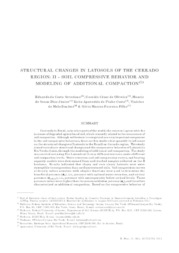Structural changes in Latosols of the Cerrado region: II - soil compressive behavior and modeling of additional compaction.
Structural changes in Latosols of the Cerrado region: II - soil compressive behavior and modeling of additional compaction.
Author(s): SEVERIANO, E. da C.; OLIVEIRA, G. C. de; DIAS JÚNIOR, M. de S.; COSTA, K. A. de P.; BENITES, V. de M.; FERREIRA FILHO, S. M. F.
Summary: Currently in Brazil, as in other parts of the world, the concern is great with the increase of degraded agricultural soil, which is mostly related to the occurrence of soil compaction. Although soil texture is recognized as a very important component in the soil compressive behaviors, there are few studies that quantify its influence on the structural changes of Latosols in the Brazilian Cerrado region. This study aimed to evaluate structural changes and the compressive behavior of Latosols in Rio Verde, Goiás, through the modeling of additional soil compaction. The study was carried out using five Latosols with very different textures, under different soil compaction levels. Water retention and soil compression curves, and bearing capacity models were determined from undisturbed samples collected on the B horizons. Results indicated that clayey and very clayey Latosols were more susceptible to compression than medium-textured soils. Soil compression curves at density values associate with edaphic functions were used to determine the beneficial pressure (o b) , i.e., pressure with optimal water retention, and critical pressure (ocrMAC), i.e., pressure with macroporosity below critical levels. These pressure values were higher than the preconsolidation pressure (op), and therefore characterized as additional compaction. Based on the compressive behavior of these Latosols, it can be concluded that the combined preconsolidation pressure, beneficial pressure and critical pressure allow a better understanding of compression processes of Latosols.
Publication year: 2011
Types of publication: Journal article
Unit: Embrapa Soils
Observation
Some of Embrapa's publications are published as ePub files. To read them, use or download one of the following free software options to your computer or mobile device. Android: Google Play Books; IOS: iBooks; Windows and Linux: Calibre.
Access other publications
Access the Agricultural Research Database (BDPA) to consult Embrapa's full library collection and records.
Visit Embrapa Bookstore to purchase books and other publications sold by Embrapa.

